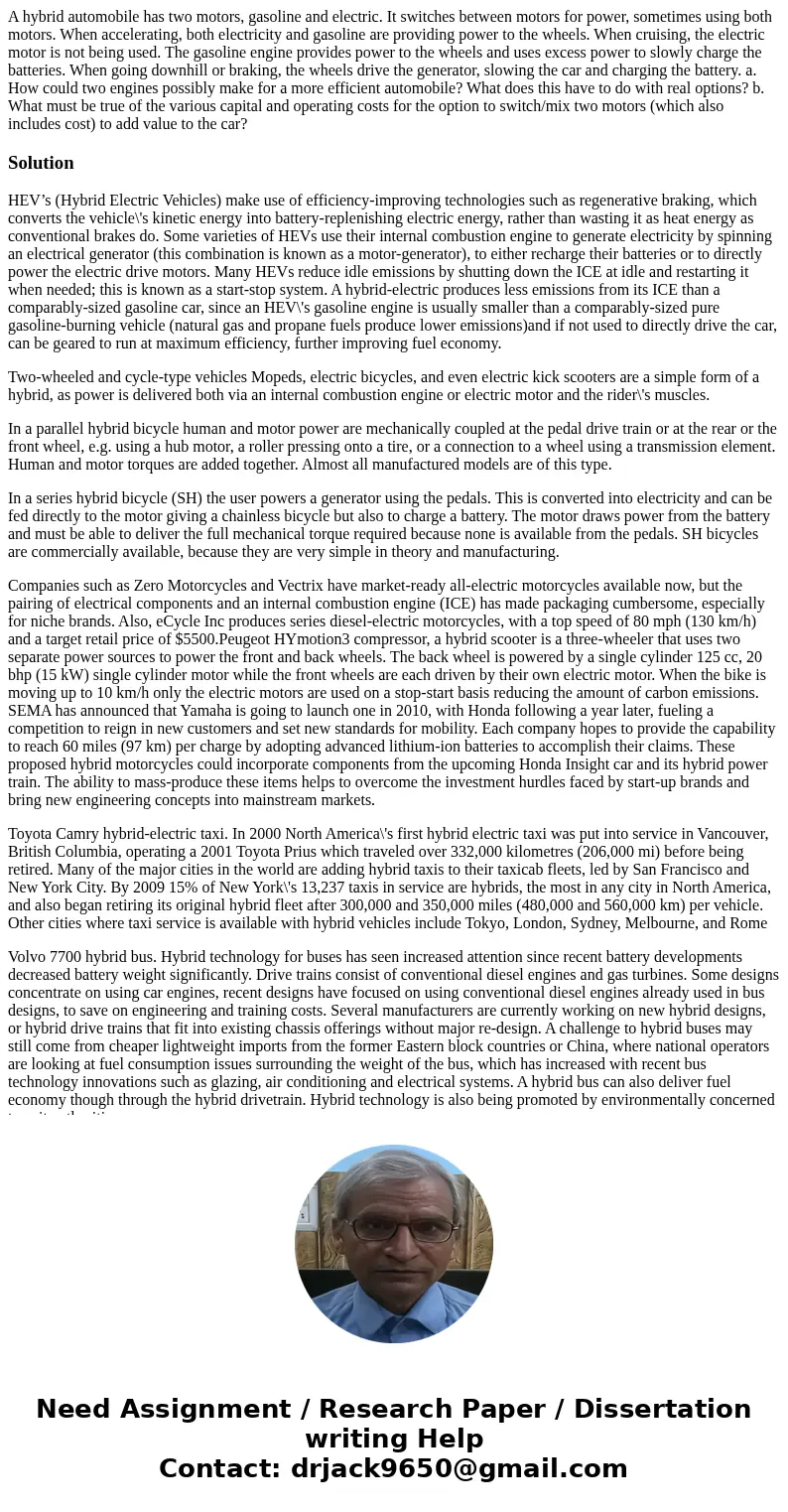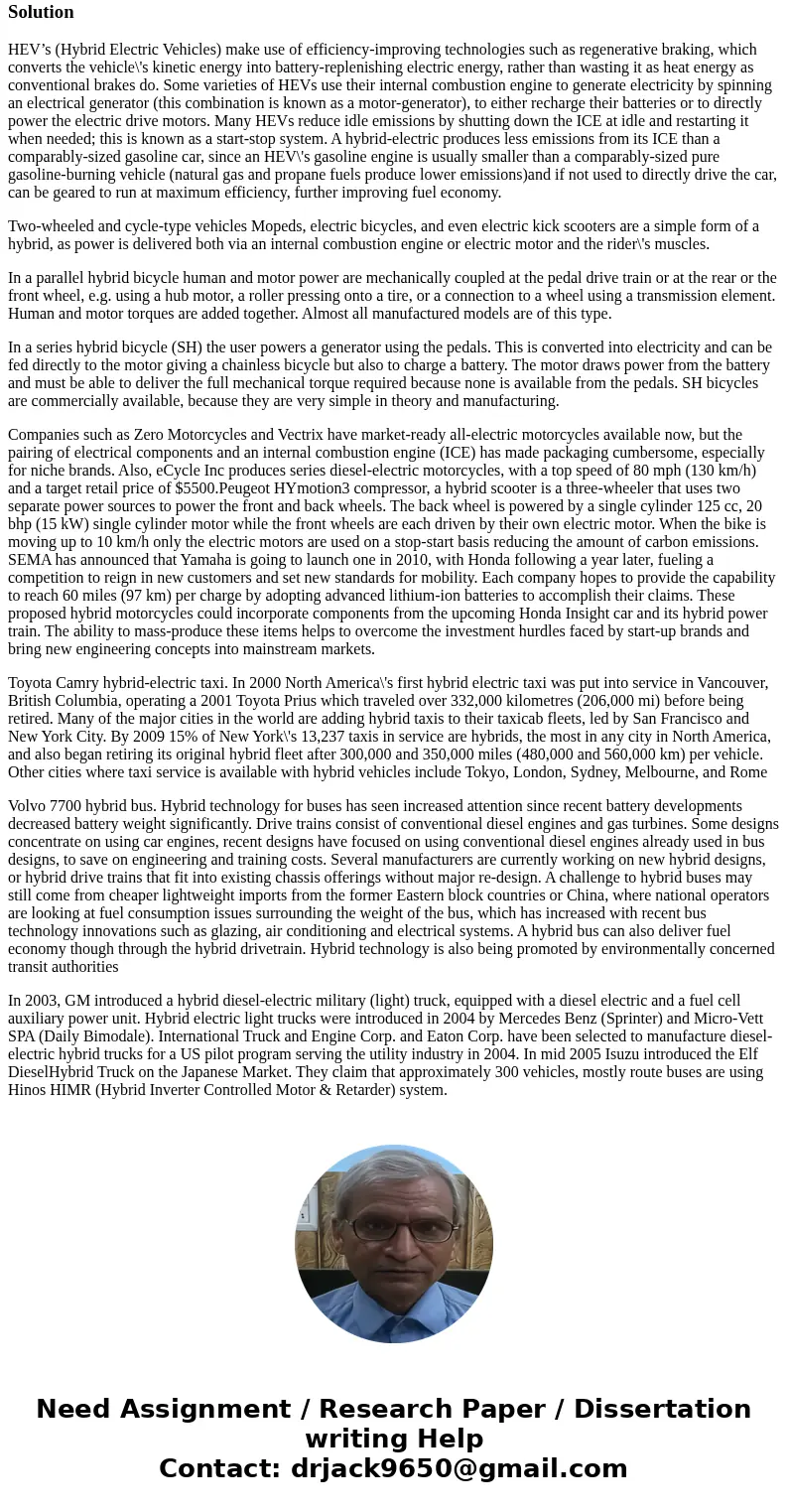A hybrid automobile has two motors gasoline and electric It
Solution
HEV’s (Hybrid Electric Vehicles) make use of efficiency-improving technologies such as regenerative braking, which converts the vehicle\'s kinetic energy into battery-replenishing electric energy, rather than wasting it as heat energy as conventional brakes do. Some varieties of HEVs use their internal combustion engine to generate electricity by spinning an electrical generator (this combination is known as a motor-generator), to either recharge their batteries or to directly power the electric drive motors. Many HEVs reduce idle emissions by shutting down the ICE at idle and restarting it when needed; this is known as a start-stop system. A hybrid-electric produces less emissions from its ICE than a comparably-sized gasoline car, since an HEV\'s gasoline engine is usually smaller than a comparably-sized pure gasoline-burning vehicle (natural gas and propane fuels produce lower emissions)and if not used to directly drive the car, can be geared to run at maximum efficiency, further improving fuel economy.
Two-wheeled and cycle-type vehicles Mopeds, electric bicycles, and even electric kick scooters are a simple form of a hybrid, as power is delivered both via an internal combustion engine or electric motor and the rider\'s muscles.
In a parallel hybrid bicycle human and motor power are mechanically coupled at the pedal drive train or at the rear or the front wheel, e.g. using a hub motor, a roller pressing onto a tire, or a connection to a wheel using a transmission element. Human and motor torques are added together. Almost all manufactured models are of this type.
In a series hybrid bicycle (SH) the user powers a generator using the pedals. This is converted into electricity and can be fed directly to the motor giving a chainless bicycle but also to charge a battery. The motor draws power from the battery and must be able to deliver the full mechanical torque required because none is available from the pedals. SH bicycles are commercially available, because they are very simple in theory and manufacturing.
Companies such as Zero Motorcycles and Vectrix have market-ready all-electric motorcycles available now, but the pairing of electrical components and an internal combustion engine (ICE) has made packaging cumbersome, especially for niche brands. Also, eCycle Inc produces series diesel-electric motorcycles, with a top speed of 80 mph (130 km/h) and a target retail price of $5500.Peugeot HYmotion3 compressor, a hybrid scooter is a three-wheeler that uses two separate power sources to power the front and back wheels. The back wheel is powered by a single cylinder 125 cc, 20 bhp (15 kW) single cylinder motor while the front wheels are each driven by their own electric motor. When the bike is moving up to 10 km/h only the electric motors are used on a stop-start basis reducing the amount of carbon emissions. SEMA has announced that Yamaha is going to launch one in 2010, with Honda following a year later, fueling a competition to reign in new customers and set new standards for mobility. Each company hopes to provide the capability to reach 60 miles (97 km) per charge by adopting advanced lithium-ion batteries to accomplish their claims. These proposed hybrid motorcycles could incorporate components from the upcoming Honda Insight car and its hybrid power train. The ability to mass-produce these items helps to overcome the investment hurdles faced by start-up brands and bring new engineering concepts into mainstream markets.
Toyota Camry hybrid-electric taxi. In 2000 North America\'s first hybrid electric taxi was put into service in Vancouver, British Columbia, operating a 2001 Toyota Prius which traveled over 332,000 kilometres (206,000 mi) before being retired. Many of the major cities in the world are adding hybrid taxis to their taxicab fleets, led by San Francisco and New York City. By 2009 15% of New York\'s 13,237 taxis in service are hybrids, the most in any city in North America, and also began retiring its original hybrid fleet after 300,000 and 350,000 miles (480,000 and 560,000 km) per vehicle. Other cities where taxi service is available with hybrid vehicles include Tokyo, London, Sydney, Melbourne, and Rome
Volvo 7700 hybrid bus. Hybrid technology for buses has seen increased attention since recent battery developments decreased battery weight significantly. Drive trains consist of conventional diesel engines and gas turbines. Some designs concentrate on using car engines, recent designs have focused on using conventional diesel engines already used in bus designs, to save on engineering and training costs. Several manufacturers are currently working on new hybrid designs, or hybrid drive trains that fit into existing chassis offerings without major re-design. A challenge to hybrid buses may still come from cheaper lightweight imports from the former Eastern block countries or China, where national operators are looking at fuel consumption issues surrounding the weight of the bus, which has increased with recent bus technology innovations such as glazing, air conditioning and electrical systems. A hybrid bus can also deliver fuel economy though through the hybrid drivetrain. Hybrid technology is also being promoted by environmentally concerned transit authorities
In 2003, GM introduced a hybrid diesel-electric military (light) truck, equipped with a diesel electric and a fuel cell auxiliary power unit. Hybrid electric light trucks were introduced in 2004 by Mercedes Benz (Sprinter) and Micro-Vett SPA (Daily Bimodale). International Truck and Engine Corp. and Eaton Corp. have been selected to manufacture diesel-electric hybrid trucks for a US pilot program serving the utility industry in 2004. In mid 2005 Isuzu introduced the Elf DieselHybrid Truck on the Japanese Market. They claim that approximately 300 vehicles, mostly route buses are using Hinos HIMR (Hybrid Inverter Controlled Motor & Retarder) system.


 Homework Sourse
Homework Sourse